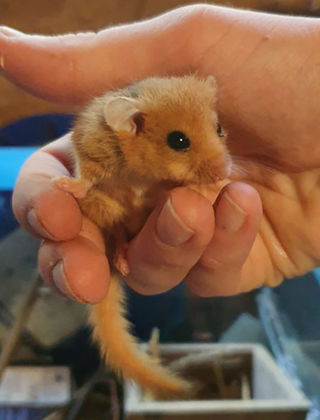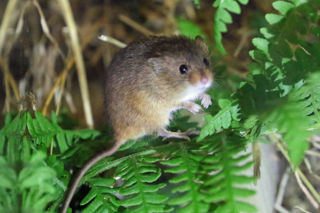
Harvest Mouse
Micromys minutus
The Harvest Mouse is Britain’s smallest rodent. They are rarely seen in the wild but their summer breeding nests are easily recognised, being balls of woven, living grass built off the ground among the stalks. The mice themselves are tiny, with golden brown fur. For a long time they were common in Britain’s wheat fields, and arable crops but the changes to traditional farming practices and mechanical harvesting means that this is no longer the case in modern times.
Description
An adult weighs just 5-6g (0.17 – 0.2 oz). It is easily identified by its small size, in combination with its blunter nose than other mice, and by its short, rounded hairy ears. The upper part of its fur is a golden-brown colour, sometimes with a yellow or red tinge, and the under-parts range in colour from white to cream. Juveniles are recognisable by their grey-brown colour. This species is the only British and European animal to possess a largely prehensile tail, which is used as a fifth limb and is usually bicoloured and furless at the tip.
The harvest mouse has broad feet that are adapted specifically for climbing, with an opposable outer toe, allowing it to grip stems with each hindfoot as well as its tail, to free the forepaws for food collection. As a result, they are adept climbers, and typically feed up in the stalk-zone of long reeds and grasses.

Breeding
The breeding nests of harvest mice are the most complex structures made by any British mammal. These spherical nests, constructed by pregnant females, are made of woven grasses and may measure up to 10cm (3.94in) in diameter. They are located up to one metre (39.4in) above ground in long grass, reed beds, hedgerows. Breeding takes place between May and October, and when the weather conditions are suitable, they may even continue to breed until December. Following a gestation period of 17-19 days, a litter usually consisting of between three and eight young (called ‘pups’), is produced, more often at night. In a good year, three litters may be born (rarely more than this), each in a separate nest. The female suckles the young until they reach around 9 days of age, at which time they are given their first solid food in the form of regurgitated chewed seeds, as well as milk. When the young reach around 18 days of age the female will abandon them. She may then go off to build a new nest for the next litter but the young will stay in the nest for a few more days before leaving. Upon reaching six weeks of age, the young will then be able to breed themselves.
Diet and Feeding
Depending on the time of year, harvest mice feed on grass seeds, berries, insects, blackfly and caterpillars, fruits, nectar and the young shoots of grasses. They have bouts of activity throughout the 24-hour period, but they tend to be more active during the evening and night. In the winter they are likely to be more active in the day when the nights are cold and long. Unlike the dormouse, they do not hibernate, but may spend some of their time in winter underground.
Habitat
Harvest mice can be found in a wide variety of habitats across their range, including alpine grasslands, tall grass fields, bamboo stands, wetlands, reedbeds, and clearings and edges of humid forest. It has also adapted to a variety of human-made habitats, including gardens, hedgerows and arable land, drainage ditches, and grain or rice paddies. It has a high tolerance of disturbed habitats because it is adaptable, intelligent and highly opportunistic.
Distribution
Over its global range, which extends in a broad band across temperate Eurasia, North to the Arctic Circle in Finland, as far South as northern Spain and most of Italy, and east into China with outposts in SE Asia, the harvest mouse is classified as being of Least Concern in the IUCN red list. In the UK, however, it is currently classified as near threatened (NT) in England, vulnerable (VU) in Wales and critical (CR) in Scotland. This mainly reflects a lack of good, clear data from the past 45 years and may change following the results of the Mammal Society led national survey, which is due to be completed in 2026.
Owing to Wildwood’s Heritage Lottery Funded five year Kent Harvest Mouse Survey, which concluded in 2020, its status, distribution and habitat preferences are well understood in this county. You can download the report from our website.
Threats and Conservation
Harvest mice have many predators, including foxes, owls, stoats, weasels, cats, crows and kestrels. Very few harvest mice live beyond 6 months, although the maximum recorded lifespan in the wild is 18 months. Other causes of mortality are cold or wet weather, flooding and sudden frosts.
The greatest threat to harvest mice also looms large over many other varieties of wildlife – habitat loss and fragmentation. Modern farming methods have not been good for the Harvest Mouse; in particular, the type of cereals we grow in our fields is very different from when the 18th century naturalist, Gilbert White, first described them and their nests in the wheat fields of Hampshire in 1767, and they are no longer leafy enough for the mice to utilise for nest-building. As a consequence they have largely disappeared from this formerly extensive habitat and moved into the narrow margins and road verges instead. Combine harvesting, the use of pesticides and, at a local level, inappropriately timed mowing of verges, hedge-cutting and ditch dredging can all have serious impacts on harvest mouse populations. There is still a strong link between arable farming and harvest mice even if it is no longer the original one. Harvest mice seem to have adapted to modern farming and in Kent, at least, may be in some sort of equilibrium. However, farming methods can evolve quickly and further rapid changes could easily prove catastrophic for the mice.
At present, harvest mice are not legally protected in Britain but they are recognised as a Species of Principal Importance for the purpose of conserving biodiversity under the Natural Environment and Rural Communities (NERC) Act 2006, and as such should be taken into account whenever development takes place. Unfortunately they are easily overlooked and are rarely taken into account.

Wildwood inside info
Wildwood is involved in the breeding of harvest mice. Well-managed captive populations provide a safety net for Britain’s wild mice, and enable successful husbandry and breeding methods to be devised. Should the species become threatened in the future, these techniques will be essential in maintaining the species, and the captive population will provide a source of reintroductions to the wild. There is usually a permanent display of harvest mice in the kiosk near the café, though from time to time it may be off-show for a while for refurbishment or veterinary treatment of the mice.
Wildwood also trains people how to survey for these elusive creatures, so that we may better understand their distribution. Between 2015-2020 we trained over 600 people ready for the Kent Harvest Mouse Survey that has resulted in us becoming one of the best surveyed counties in the country. It has also paved the way for other surveys to follow elsewhere, and there is now a national survey underway. You too can learn to identify signs of harvest mice in the wild and help further our knowledge of the species. Look out for one of the conservation courses on our website.
Family facts
They are so tiny that they can weigh as little as a 20p piece.
They have a prehensile (capable of gripping) tip to their tail, which helps them to climb.
They have sharp hearing and will freeze or dive for cover if they hear a rustling noise up to 7m away.
They are skilled ‘engineers’ and support their nests in a variety of ingenious ways.
They often build their nest over water and will swim to escape danger.


